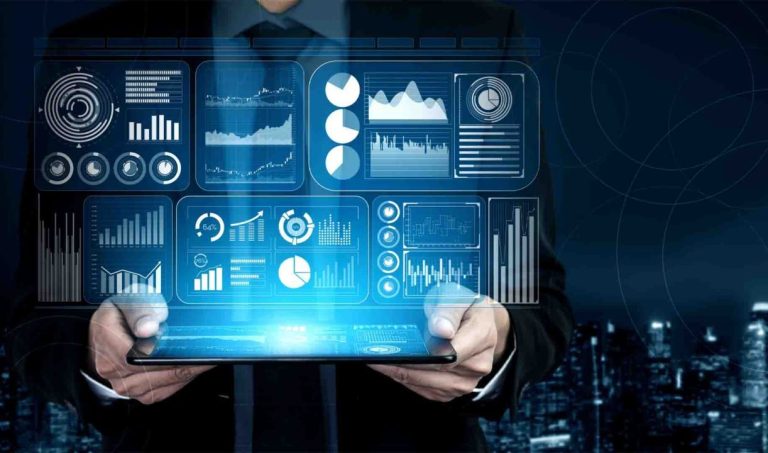Augmented analytics, continuous intelligence and explainable artificial intelligence (AI) are among the top trends in data and analytics technology that have significant disruptive potential over the next three to five years, according to Gartner, Inc.
From the moment you integrate AI in BI, it does all the heavy lifting by automatically classifying columns, tagging them and joining matching data across sets.
In minutes, you can go from uploading datasets to uncovering hidden truths in your data and presenting those findings in compelling, beautiful visualizations.
Table of Contents
“Data and analytics will become the centerpiece of enterprise strategy, focus and investment”
Why is AI becoming all-pervasive?

An AI model that once took weeks to train now takes days, or even just a few hours, using machine learning.
Another factor is more access to data than ever before.
You might have heard that your data is a goldmine of powerful insights.
All this data must be processed with advanced tools such as analytics and machine learning algorithms to reveal meaningful insights.
This processing is where AI in BI becomes an invaluable tool.
7 Real-world use cases of AI in BI applications
1. SAP – AI for turning databases into useful intel
HANA is SAP’s cloud platform.
It ingests and replicates structured data from relational databases, apps and other sources.
The platform is installed to run on-premise, either through a company’s server or via the cloud.
HANA stores information gathered from access points across the business—including mobile, desktop computers, financial transactions, sensors and equipment at production plants.
If your sales team uses company smartphones or tablets in the field to record purchase orders, data from those transactions can be analyzed and understood by HANA to spot trends and irregularities.
Read how – Walmart uses Hana.
2. DOMO – AI for business dashboards
DOMO developed a cloud-based dashboard that can scale with the size of the company.
DOMO comes with 400 native software connectors that collect data from third-party apps.
This data offers insights and gives context to business intelligence.
With DOMO, companies can pull data from Salesforce, Square, Facebook, Shopify and other applications to gain insight on their customers, sales or product inventory.
The extracted information can be used generate reports and spot trends, which can be shared to any device used by the company.
DOMO also introduced a set of new features for the platform that draw upon AI, machine learning and predictive analytics.
Mr. Roboto can help companies predict the return on investment for marketing in real-time, customer churn and sales forecasts.
3. Apptus – AI in sales enablement
Apptus specializes in the connection between a customer’s intent to buy and the realization of revenue by a company.
The software combines big data and machine learning to determine which products would appeal to a potential customer as they search online or get recommendations.
When a customer visits an online store that uses Apptus eSales and starts to type products in the search engine, the machine learning solution can predict and automatically display related search phrases.
It can also display related products associated with those search terms.
4. Avanade – AI for business insights
Avanade leverages the Cortana Intelligence Suite and other solutions for predictive analytics and data-based insights.
An insurance company, Pacific Specialty tapped Avanade built an analytics platform to use customer and policy data to help drive more growth.
By tracking policyholder behavior and trends through analytics, the idea was to better advise the development of new products.
5. AI in BI – Predicting repairs, monitoring machine fleets and factories

Oil and gas, aviation and other industries process the historic performance data of equipment.
It is then used to discern a variety of operational outcomes such as when machinery might fail and so on.
This is done through apps developed by GE as well as third parties.
Accenture’s Intelligent Pipeline Solution, for instance, is used to monitor millions of miles of oil pipelines around the world.
That includes taking data from pipeline assets and external sources to manage safety and how resources are used.
The result is reduced downtime and reduced costs of operation.
AI in BI can also be used to keep track of machine tools at plants around the world and see performance stats of their assets. It helps schedule preventive maintenance and manage how equipment is used to improve their operational lifespan.
6. Embedded BI
Business intelligence software will soon become more embedded in well-established workflows.
With advanced integrations, users will be able to access the necessary systems.
The functions of third-party systems will be built-in to your business intelligence tool, thereby offering a full-service platform.
You can interact with data without ever leaving your business intelligence software.
Having all programs intertwined, you will be able to quickly pull data from all sources and consolidate the information, streamlining workflows.
7. Data “Proactivity”
Soon we are more likely to have information brought to us than looking for it in reports or dashboards.
A 2011 Quora post by Jason Kolb shows emphasis on this trend. “Relevant data will find you, and not vice versa,” Kolb writes.
The concept of data proactivity is related to third-party program integrations and AI.
To put it simply, all these features offer the benefit of providing answers based on your business’ stored data.
Whether you directly engage with the system or not, an intuitive tool will bring the answers to you.
“Leading organizations in every industry are wielding data and analytics as competitive weapons”
Top 6 AI-powered business intelligence platforms

BI tools make it simpler to collate the right data and visualize it in ways that enable us to understand what it means.
Yet how simple that process gets and how you can visualize the data depends on the tool.
Hence, picking the right tool for your needs becomes critical.
Board- Board combines three tools in one – BI, predictive analytics and performance management.
It has modules for finance, HR, marketing, supply chain, sales and IT.
The latest version of its platform has replaced its multidimensional online analytical processing (MOLAP) approach with an in-memory calculation engine
Microsoft Power BI – With Power BI, users can analyze and visualize data from local or cloud sources.
It offers data preparation, visual-based discovery, interactive dashboards and augmented analytics.
Qlik Sense- Qlik’s goal is to give anyone in the enterprise access to all its data — subject, of course, to corporate data governance policies.
Its Associative Engine can associate every piece of data with every other piece to make it easier to search for connections.
The Associative Engine now has AI and machine learning capabilities that offer context-aware insight suggestions thanks to the Qlik cognitive engine
Tableau – Tableau’s capabilities include mapping and analysis of surveys and time series data.
Its latest trick is drawing on the artificial intelligence techniques of natural language processing to allow users to describe what they want to see, rather than clicking and dragging to create formulaic queries.
Dundas BI – Dundas BI from Dundas Data Visualization is used for creating dashboards and scorecards.
Analysis and visualization are performed through a web interface that can adapt to users’ skills.
The latest version has a new in-memory engine, a new natural language query capability and adds point-and-click trend analysis, support for Linux and an application development environment for customized analytic applications.
Dundas BI has been tailored for 19 industries, including clean tech, mining and construction and it specializes in embedded BI
SAP HANA – SAP’s vision for BI and analytics revolves around using real-time collective insights in the business landscape.
SAP Lumira also delivers agile visualizations to help companies make the most of their data, while SAP predictive analysis applies advanced analytics to the roadmap.
Concluding thoughts on AI in BI
The future of BI will be much more automated and aggressively utilized, with fewer bottlenecks in terms of interface limitations and the free flow of data.
According to Gartner’s analysis, 50 percent of analytical queries will be generated via search, natural language processing or voice in the very near future.
Conversational Analytics will change BI from a back-office task to one that may be as simple as using a voice assistant.
Data democratization will most likely be a key driver behind this trend and it will empower non-technical users to run analysis on a scale seen never before in businesses.
















